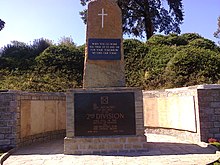Kohima
Kohima (/koʊˈhiːmə/ ⓘ; Angami Naga: Kewhira (IPA: [ˈkɛʍɪɻə])) is the capital of the North East Indian state of Nagaland.
The city lies on the foothills of Japfü section of the Barail Range located south of the District (25°40′N 94°07′E / 25.67°N 94.12°E / 25.67; 94.12)[2] and has an average elevation of 1,261 m (4,137 ft).
It became an urban centre in 1878 when the British Empire established its headquarters of the then Naga Hills District of Assam Province.
[8] According to oral history, the historical founder of Kewhira (Kohima Village) was Tsiera (stone defender).
[8] The village is divided into four large clans (thinuo): Tsütuonuomia, Lhisemia, Dapfhütsumia and Pfüchatsumia (T, L, D, and P Khel respectively).
Kohima was the first seat of modern administration as the Headquarters of Naga Hills District (then under Assam Province) with the appointment of Guybon Henry Damant as Political Officer in 1879.
This hand-to-hand battle and slaughter prevented the Japanese Army from gaining a base from which they might have easily gone into the plains of India.
The verse is attributed to John Maxwell Edmonds (1875–1958), and is thought to have been inspired by the epitaph written by Simonides to honour the Greek who fell at the Battle of Thermopylae in 480 BC.
[15] On 20 March 1986, two students Kekuojalie Sachü and Vikhozo Yhoshü were killed in indiscriminate firing by Nagaland Police when they participated in a peaceful protest called by the Naga Students' Federation (NSF) to rally against the state government's decision on the introduction of Indian Police Service (IPS) cadres and the extension of the Disturbed Area Belt from 5 to 20 km along the Indo-Myanmar (Indo-Burma) border.
[16] On 5 March 1995, when a convoy of the 16th Rashtriya Rifles of the Indian Army was traversing through Kohima, a tyre burst from one of the convoy's own vehicle led the armed troops to mistake the sound of the tyre bursting for a bomb attack.
[17][18] On 2 February 2017, the office building of the Kohima Municipal Council was burned down by a mob as part of the boycott of the Civic Elections.
[19][20] On 19 February, in response against the backdrop of widespread protests and civil unrest in the state, T. R. Zeliang announced his resignation as the Chief Minister of Nagaland.
[24] The city experiences a subtropical highland climate (Köppen: Cwb), with greater contrast between summer and winter than in other continents due to the monsoons but mild temperatures even for latitude and altitude.
[30] The current water resources from the reservoirs of Zarü River and the streams from the slopes of Pulie Badze do not fulfill the needs of the rapidly growing population of Kohima.
[31] The Kohima Municipal Council (KMC) was established in 2005 under India's Constitution (Seventy-Fourth Amendment) Act, 1992.
[36] In 2020, the Kohima North Police Station became the first police station and a government facility in the entire North Eastern Region of India to receive the International Organization for Standardization (ISO) 9001 Certification for quality management system.
[37][38] Nagaland's traditional governance system persists in rural areas and urban Kohima through ward panchayats.
Each ward elects a panchayat chairman every five years by a show of hands, who then appoints officials, including joint secretaries and Gaon Burhas (GBs).
[39] The Kohima Town Committee (KTC) was established in 1957 with 8 wards, 8 elected members, and 4 government nominees.
The Kohima Municipal Council (KMC) remains in a transitional phase, with its powers and functions under the 74th Constitutional Amendment Act yet to be fully transferred by state government departments.
[47] Kohima Botanical Garden is located at New Ministers' Hill Ward and is looked after by the Nagaland Forest Department.
The festival is held every year from 1 to 10 December with the purpose to promote the richness of the Naga heritage and traditions.
[54][55][56] The Nagaland State Museum is located in Bayavü Hill and displays a comprehensive collection of artefacts including ancient sculptures, traditional dresses, inscriptions of the Naga people.
[63] State-owned All India Radio has a local station in Kohima, which transmits various programs of mass interest like AIR FM Tragopan, etc.
[67] Due to a dispute over land acquisition the track was resurveyed and an alternative alignment was proposed in 2013 and is expected to be completed by 2026.





